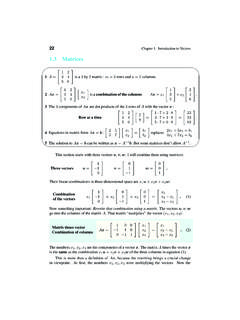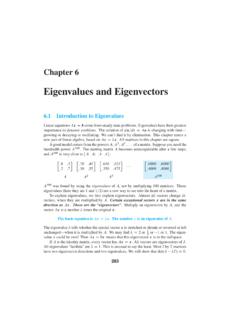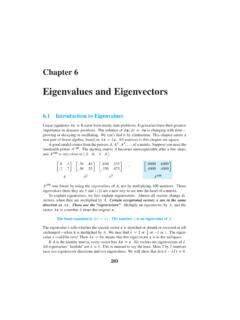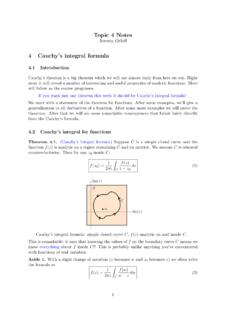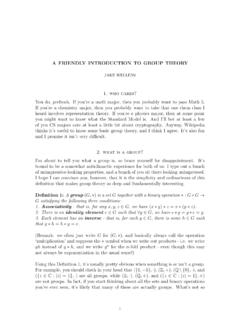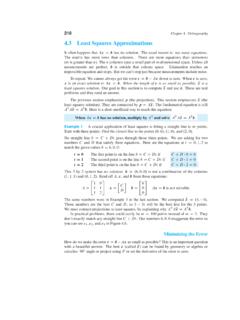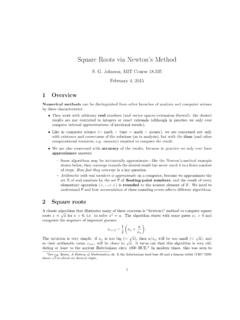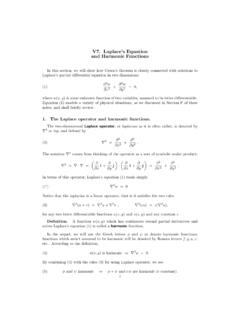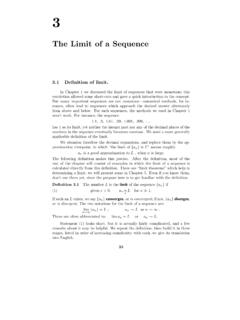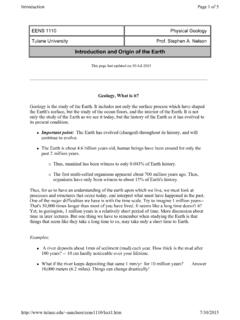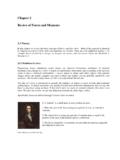Transcription of 18.03 LECTURE NOTES, SPRING 2014 - MIT Mathematics
1 LECTURE NOTES, SPRING 2014. BJORN POONEN. 7. complex numbers complex numbers are expressions of the form x + yi, where x and y are real numbers, and i is a new symbol. Multiplication of complex numbers will eventually be defined so that i2 = 1. (Electrical engineers sometimes write j instead of i, because they want to reserve i for current, but everybody else thinks that's weird.) Just as the set of all real numbers is denoted R, the set of all complex numbers is denoted C. Flashcard question: Is 9 a real number or a complex number ? Possible answers: 1. real number 2. complex number 3. both 4. neither Answer: Both, because 9 can be identified with 9 + 0i. Operations on complex numbers. real part Re(x + yi) := x imaginary part Im(x + yi) := y (Note: It is y, not yi, so Im(x + yi) is real). complex conjugate x + yi := x yi (negate the imaginary component).
2 One can add, subtract, multiply, and divide complex numbers (except for division by 0). Addition, subtraction, and multiplication are as for polynomials, except that after multiplication one should simplify by using i2 = 1; for example, (2 + 3i)(1 5i) = 2 7i 15i2. = 17 7i. To divide z by w, multiply z/w by w/w so that the denominator becomes real; for example, 2 + 3i 2 + 3i 1 + 5i 2 + 13i + 15i2 13 + 13i 1 1. = = 2. = = + i. 1 5i 1 5i 1 + 5i 1 25i 26 2 2. The arithmetic operations on complex numbers satisfy the same properties as for real numbers (zw = wz and so on). The mathematical jargon for this is that C, like R, is a field. In particular, 1. for any complex number z and integer n, the nth power z n can be defined in the usual way (need z 6= 0 if n < 0); , z 3 := zzz, z 0 := 1, z 3 := 1/z 3 . (Warning: Although there is a way to define z n also for a complex number n, when z 6= 0, it turns out that z n has more than one possible value for non-integral n, so it is ambiguous notation.)
3 Anyway, the most important cases are ez , and z n for integers n;. the other cases won't even come up in this class.). If you change every i in the universe to i (that is, take the complex conjugate everywhere), then all true statements remain true. For example, i2 = 1 becomes ( i)2 = 1. Another example: If z = vw, then z = v w. The complex plane. Just as real numbers can be visualized as points on a line, complex numbers can be visualized as points in a plane: plot x + yi at the point (x, y). Addition and subtraction of complex numbers has the same geometric interpretation as for vectors. The same holds for scalar multiplication of a complex number by a real number . (The geometric interpretation of multiplication by a complex number is different; we'll explain it soon.) complex conjugation reflects a complex number in the real axis.
4 2. The absolute value (or magnitude or modulus) |z| of a complex number z = x + iy is its distance to the origin : p |x + yi| := x2 + y 2 (this is a real number ). For a complex number z, inequalities like z < 3 do not make sense, but inequalities like |z| < 3 do, because |z| is a real number . The complex numbers satisfying |z| < 3 are those in the open disk of radius 3 centered at 0 in the complex plane. (Open disk means the disk without its boundary.). Some useful identities. The following are true for all complex numbers z: z+z z z Re z = , Im z = , z = z, zz = |z|2 . 2 2i Also, for any real number a and complex number z, Re(az) = a Re z, Im(az) = a Im z. (These can fail if a is not real.). z+z (x+yi)+(x yi). Proof of the first identity: Write z as x + yi. Then Re z = x and 2. = 2. =x too. The proofs of the others are similar.
5 complex roots of polynomials. real polynomial : polynomial with real coefficients complex polynomial : polynomial with complex coefficients Example How many roots does the polynomial z 3 3z 2 + 4 have? It factors as (z 2)(z 2)(z + 1), so it has only two distinct roots (2 and 1). But if we count 2. twice, then the number of roots counted with multiplicity is 3, equal to the degree of the polynomial. 3. Some real polynomials, like z 2 + 9, cannot be factored completely into degree 1 real polynomials, but do factor into degree 1 complex polynomials: (z + 3i)(z 3i). In fact, every complex polynomial factors completely into degree 1 complex polynomials this is proved in advanced courses in complex analysis. This implies the following: Fundamental theorem of algebra. Every degree n complex polynomial f (z) has exactly n complex roots, if counted with multiplicity.
6 Since real polynomials are special cases of complex polynomials, the fundamental theorem of algebra applies to them too. For real polynomials, the non-real roots can be paired off with their complex conjugates. Example The degree 3 polynomial z 3 + z 2 z + 15 factors as (z + 3)(z 1 2i)(z 1 + 2i), so it has three distinct roots: 3, 1 + 2i, and 1 2i. Of these roots, 3 is real, and 1 + 2i and 1 2i form a complex conjugate pair. Example Want a fourth root of i? The fundamental theorem of algebra guarantees that z 4 i = 0 has a complex solution (in fact, four of them). We'll soon learn how to find them. The fundamental theorem of algebra will be useful for constructing solutions to higher order linear ODEs with constant coefficients, and for discussing eigenvalues. February 12. Real and imaginary parts of complex -valued functions.
7 Suppose that y(t) is a complex -valued function of a real variable t. Then y(t) = f (t) + i g(t). for some real-valued functions of t. Here f (t) := Re y(t) and g(t) := Im y(t). Differentiation and integration can be done component-wise: y 0 (t) = f 0 (t) + i g 0 (t). Z Z Z. y(t) dt = f (t) dt + i g(t) dt. 2 + 3i Example Suppose that y(t) = . Then 1 + it . 2 + 3i 2 + 3i 1 it (2 + 3t) + i(3 2t) 2 + 3t 3 2t y(t) = = = = +i . 1 + it 1 + it 1 it 1 + t2 1 + t2 1 + t2. | {z } | {z }. f (t) g(t). The functions in parentheses labelled f (t) and g(t) are real-valued, so these are the real and imaginary parts of the function y(t). 2. 4. The complex exponential function. Derivatives and DEs make sense for complex - valued functions of a complex variable z, and work in a similar way. In particular, the existence and uniqueness theorem shows that there is a unique such function f (z) satisfying f 0 (z) = f (z), f (0) = 1.
8 This function is called the complex exponential function ez . The number e is defined as the value of ez at z = 1. But it is the function ez , not the number e, that is truly important. Defining e without defining ez first is a little unnatural. And even if e were defined first, one could not use it to define ez , because e raised to a complex number has no a priori meaning. Theorem The complex exponential function ez has the following properties: (a) The derivative of ez is ez . (b) e0 = 1. (c) ez+w = ez ew for all complex numbers z and w. 1. (d) (ez )n = enz for every complex number z and integer n. The n = 1 case says =. ez (ez ) 1 = e z . (e) Euler's identity: eit = cos t + i sin t for every real number t. (f) More generally, ex+yi = ex (cos y + i sin y) for all real numbers x and y. (1). (g) e it = eit = cos t i sin t for every real number t.
9 (h) |eit | = 1 for every real number t. Of lesser importance is the power series representation z2 z3. ez = 1 + z + + + . (2). 2! 3! This formula can be deduced by using Taylor's theorem with remainder, or by showing that the right hand side satisfies the DE and initial condition. Some books use (1) or (2) as the definition of the complex exponential function, but the DE definition we gave is less contrived and focuses on what makes the function useful. Proof of Theorem (a) True by definition. (b) True by definition. (c) As a warm-up, consider the special case in which w = 3. By the chain rule, ez+3 is the solution to the DE with initial condition f 0 (z) = f (z), f (0) = e3 . 5. The function ez e3 satisfies the same DE with initial condition. By uniqueness, the two functions are the same: ez+3 = ez e3 . The same argument works for any other complex constant w in place of 3, so ez+w = ez ew.
10 (d) If n = 0, then this is 1 = 1 by definition. If n > 0, n copies n copies z }| {. (c) repeatedly z + z + + z z }| {. (ez )n = ez ez ez = e = enz . If n = m < 0, then 1 (just shown) 1. (ez ) m = = = e mz (ez )m emz since emz e mz = emz+( mz) = e0 = 1. (e) The calculation d (cos t + i sin t) = sin t + i cos t dt = i(cos t + i sin t). shows that the function cos t + i sin t is the solution to the DE with initial condition f 0 (t) = if (t), f (0) = 1. But eit is a solution too, by the chain rule. By uniqueness, the two functions are the same (the existence and uniqueness theorem applies also to complex -valued functions of a real variable t). (f) By (c) and (e), ex+yi = ex eiy = ex (cos y + i sin y). (g) Changing every i in the universe to i transforms eit = cos t+i sin t into e it = cos t i sin t. (Substituting t for t would do it too.)
